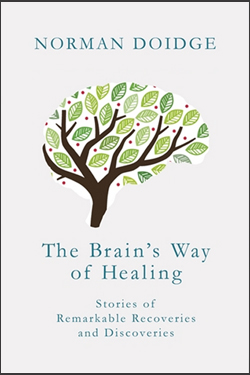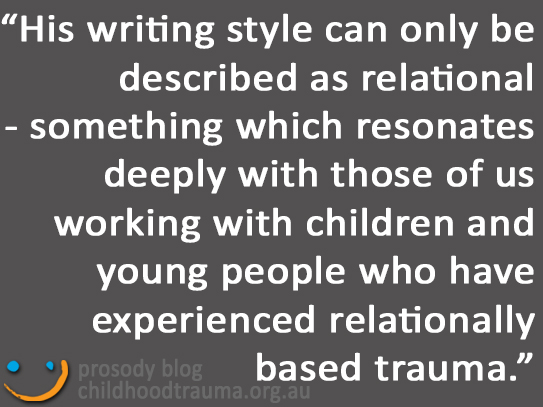
Reviewing ‘The brain’s way of healing- remarkable discoveries and recoveries from the frontiers of neuroplasticity’

This article was authored by Marina Dickson,
Program Manager, Vocational Training and Education at the Australian Childhood Foundation.
Many of our members of the Prosody community will have read Norman Doidge’s book, ‘The brain that changes itself’ (2007). It introduced many ideas and concepts from the body of evidence of neuroplasticity to the world- given it was a bestseller long after its release.
Norman Doidge has recently released his next book, ‘The brain’s way of healing’ and it is timely to provide a review of this text.
 In this book, Doidge focuses on what neuroplasticity can teach us about healing and repair. His focus is on a range of illnesses, from Parkinson’s to Multiple Sclerosis to Autism Spectrum Disorder. For those of us working in any way from a trauma informed perspective, these stories of hope and repair provide some cues and guides to what might influence our practice- whether it is in medicine or even social work, psychology or other non-medical disciplines.
In this book, Doidge focuses on what neuroplasticity can teach us about healing and repair. His focus is on a range of illnesses, from Parkinson’s to Multiple Sclerosis to Autism Spectrum Disorder. For those of us working in any way from a trauma informed perspective, these stories of hope and repair provide some cues and guides to what might influence our practice- whether it is in medicine or even social work, psychology or other non-medical disciplines.
The main tenet of Doidge’s model is what he calls ‘the stages of neuroplastic healing’ (p. 101) and I attempt here to summarise this model, albeit from my perspective as a social worker and trainer.
Firstly, Doidge suggests that good health and nutrition are very helpful in supporting the healthy development of the parts of the brain associated with the ‘blood-brain barrier’- keeping the brain free from unhealthy invaders. He then moves into the four stages associated with directly ‘rewiring’ the brain.
- Neurostimulation- this refers to the need for some kind of energy to stimulate the neurons into action that is focused on repair and healing. This energy can be internal or external and examples discussed throughout the book include light, sound, vibration and movement. Doidge also suggests, ‘Everyday thought, especially when used systematically, is a potent way to stimulate neurons.’(p. 109)
- Neuromodulation- this stage speaks to resetting the balance in the brain between amplification (or excitation) and inhibition as this supports our capacity to regulate our arousal levels. This links to some of our learning about the neurobiology of trauma as Doidge discusses neuromodulation in terms of regulating the sleep-wake cycle- controlled within the brain stem- and the autonomic nervous system, particular the fight-flight response.
- Neurorelaxation- neuromodulation enables the brain to then engage in neurorelaxation which focuses on storing energy supplies needed to support full recovery. Doidge discusses examples where people who have experienced neuromodulation then feel exhausted and a strong need for sleep- which is recuperative in itself.
- Neurodifferentiation and learning- this stage is the point at which new learning can occur and the brain is most able to differentiate rather than generalise its responses. Differentiation means making fine distinctions and brings about flexibility and new neuronal activity that supports change and repair. Doidge makes the point that learning is much more than a cortical, thought based, process as it occurs throughout the brain and body.
As Doidge reiterates, these stages form a flexible framework rather than a staged and rigid set of steps.
He also points out that these are underpinned by 3 critical brain processes- often linked to brains struggling to integrate their functioning. These are ‘the pervasiveness of learned non-use’ (p. 102), ‘the noisy brain and brain dysrhythmias’ (p.103) and ‘the rapid ongoing formation of neuronal assemblies’ (p.105)
The final chapter is of particular interest to the Prosody community as it discusses the use of sound, particularly the use of music, in reparative activities with children. It also references the work of Stephen Porges who is currently partnering with the Australian Childhood Foundation in undertaking his listening based therapy with children in Australia who have experienced abuse related trauma.
 While the content of Doidge’s book is both fascinating and relevant, comment must also be made of the style in which he presents this information to us. His writing style can only be described as relational- something which resonates deeply with those of us working with children and young people who have experienced relationally based trauma. Not only do we hear about the medical breakthroughs and scientific grounding of these new ways of using the knowledge of neuroplasticity but we also hear the stories of the people making these changes to practice as well as the clients they work with and support. This heartfelt and genuine approach connects the reader with what could be a disconnecting and overly technical bombardment of theory in a way that makes the book both an interesting and engaging read.
While the content of Doidge’s book is both fascinating and relevant, comment must also be made of the style in which he presents this information to us. His writing style can only be described as relational- something which resonates deeply with those of us working with children and young people who have experienced relationally based trauma. Not only do we hear about the medical breakthroughs and scientific grounding of these new ways of using the knowledge of neuroplasticity but we also hear the stories of the people making these changes to practice as well as the clients they work with and support. This heartfelt and genuine approach connects the reader with what could be a disconnecting and overly technical bombardment of theory in a way that makes the book both an interesting and engaging read.
However, for those who are looking for depth of theory and research, the extensive notes and references section (pp. 368 – 394) and index provide a veritable bookcase of further reading and knowledge building opportunities.
This resource is a strong addition to the knowledge of neuroplasticity and will certainly be included and integrated into the work of the Australian Childhood Foundation including the Graduate Certificate in Developmental Trauma. It is perhaps no surprise to hear that I recommend this book for those wishing to extend their knowledge and challenge their thinking.
Bibliographic details
Doidge, N (2015) The brain’s way of healing: remarkable discoveries and recoveries from the frontiers of neuroplasticity. Scribe Publications: Victoria
